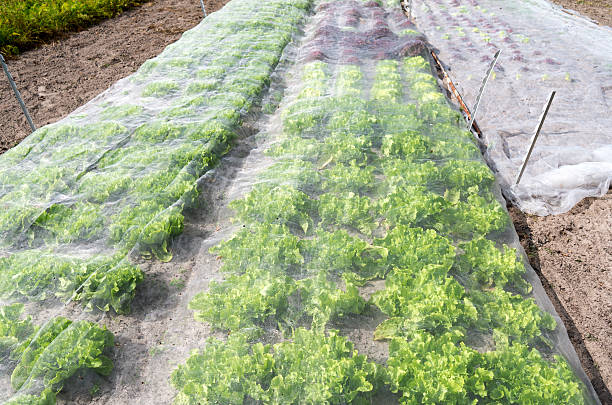Selecting the right garden netting is paramount for any gardener striving to protect their plants and maximize their yield. The choice of netting can mean the difference between a thriving garden and disappointment. Perfect garden netting not only effectively protects plants from pests and adverse weather conditions but also fits seamlessly into your gardening routine, offering durability, functionality, and ease of use.
In this comprehensive guide, we aim to provide you with all the necessary information to make an informed decision when selecting garden netting. From understanding the different types of netting materials to practical tips for installation and maintenance, we cover it all:
Understanding Garden Netting
Garden netting is a protective barrier made from various materials such as plastic, nylon, or mesh. It serves the purpose of shielding plants from pests, harsh weather, and other environmental factors. Different types of garden netting materials offer varying levels of durability, flexibility, and resistance to weather elements. Understanding these materials is crucial for selecting the most suitable netting for your garden.
Garden netting comes in a variety of designs and sizes to accommodate different gardening needs and preferences. Whether you need bird netting to deter avian pests or shade netting to regulate sunlight exposure, there’s a netting option for you. The primary function of garden netting is to create a physical barrier around plants, preventing pests from accessing them and protecting them from damage caused by wind, hail, frost, and excessive sunlight.
Factors to Consider When Selecting Garden Netting
Selecting the perfect garden netting involves careful consideration of several key factors to ensure optimal protection and support for your plants.
- Assessing your garden’s specific needs and challenges is the first step in selecting the perfect netting. Consider factors such as the type of plants you’re growing, the prevalent pests in your area, and the climate conditions.
- Identify potential threats to your garden, such as insect infestations, bird damage, or extreme weather events. Understanding these threats will help you choose the most appropriate type of netting for protection.
- Evaluate the durability and effectiveness of different netting materials. Look for high-quality materials that offer longevity and optimal protection against pests and environmental factors.
- Budget constraints and long-term investment should also be taken into account when selecting garden netting. While it’s essential to choose netting that fits your budget, investing in quality netting can save you money in the long run by reducing crop losses and the need for chemical pesticides.
Choosing the Right Type of Garden Netting
Garden netting serves as a vital defense mechanism for protecting plants against various threats, ranging from pesky pests to unpredictable weather conditions. However, selecting the right type of garden netting is crucial to ensure optimal protection and support for your plants. Let’s explore the different types of garden netting available and their specific applications:
Bird Netting
Bird netting is specifically designed to deter avian pests such as sparrows, pigeons, and starlings, which can cause significant damage to crops by pecking at fruits and vegetables. This type of netting features small mesh sizes that prevent birds from accessing plants while allowing sunlight, air, and moisture to penetrate. Bird netting is commonly used to protect fruit trees, berry bushes, and vegetable patches from bird damage.
Example: A fruit orchard owner installed bird netting over their cherry trees to prevent birds from devouring the ripe fruit. As a result, they were able to harvest a bumper crop of cherries without any losses to bird damage.
Insect Netting
Insect netting acts as a physical barrier to keep out a wide range of garden pests, including aphids, caterpillars, beetles, and leafhoppers. This fine mesh netting prevents insects from reaching plants, laying eggs, and causing damage. Insect netting is particularly useful for protecting tender crops such as lettuce, cabbage, and broccoli, which are susceptible to insect infestations.
Example: A vegetable gardener installed insect netting over their raised beds to safeguard their crops from pests. Thanks to the netting, they were able to enjoy a pest-free harvest of fresh vegetables throughout the growing season.
Shade Netting
Shade netting is designed to regulate sunlight exposure and temperature in the garden, providing protection from intense sunlight and heat. This type of netting is made from materials that filter sunlight, reducing its intensity without blocking essential nutrients. Shade netting is beneficial for delicate plants that are prone to sunburn, as well as for extending the growing season in hot climates.
Example: A gardener in a sunny region installed shade netting over their lettuce bed to prevent the leaves from wilting in the scorching sun. The shade netting created a cooler, more favorable environment for the lettuce, resulting in healthier, happier plants.
Frost Netting
Frost netting, also known as frost cloth or frost protection fabric, provides insulation against frost damage during cold weather spells. This lightweight fabric is draped over plants to create a protective barrier that traps heat and prevents frost from settling on leaves and buds. Frost netting is essential for protecting tender plants in early spring and late fall when frost is a threat.
Example: A gardener used frost netting to cover their tomato plants during an unexpected late frost. Despite the chilly temperatures, the tomato plants remained unharmed under the protective layer of frost netting, ensuring a successful harvest later in the season.
Deer and Animal Netting
Deer and animal netting are heavy-duty barriers designed to deter larger wildlife such as deer, rabbits, raccoons, and squirrels from accessing the garden. This type of netting features sturdy construction and a taller height to prevent animals from jumping or climbing over. Deer and animal netting are essential for protecting valuable crops and ornamental plants from wildlife damage.
Example: A homeowner installed deer netting around their vegetable garden to keep out hungry deer that frequently roamed through their yard. With the deer netting in place, they were able to enjoy a flourishing garden without any losses to deer browsing.
Conclusion
Selecting the perfect garden netting is essential for protecting your plants and maximizing your garden yield. By considering factors such as your garden’s specific needs, potential threats, and budget constraints, you can choose the most suitable netting for your garden.
Whether you need protection against pests, adverse weather conditions, or wildlife, there’s a type of netting that’s perfect for you. With proper installation and maintenance, garden netting can help you achieve a thriving and bountiful garden year after year.









